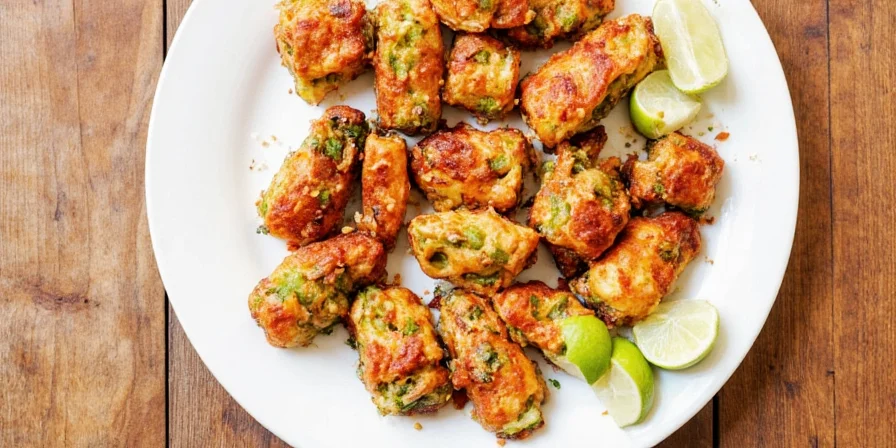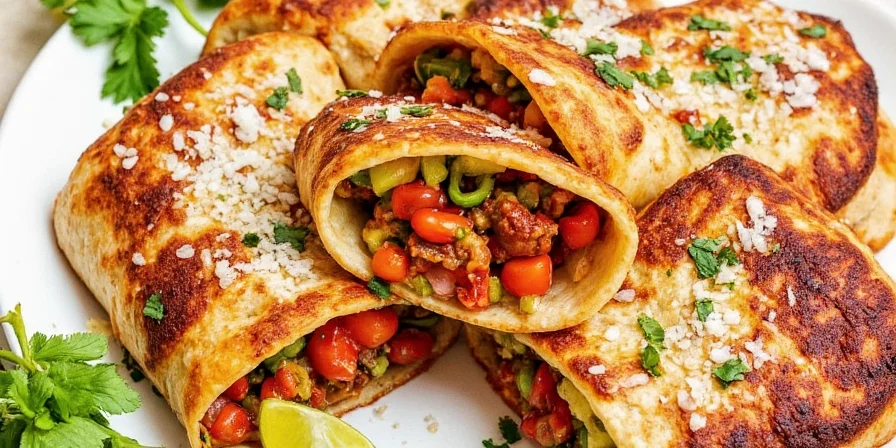Welcome, home cooks seeking to master plant-based Mexican cuisine! If you thought chimichangas were merely fried tortillas with beans and rice, reconsider. This street food staple becomes your canvas for transformative spice innovation. Discover how to elevate your veg chimichanga recipe from ordinary to extraordinary using scientifically grounded flavor combinations that deliver restaurant-quality results in your kitchen.
Table of Contents
- What Exactly Is a Veg Chimichanga?
- Why Spices Are Your Culinary Catalyst
- Top 7 Innovative Spice Pairings for Your Veg Chimichanga
- Pro Tips for Building the Perfect Chimichanga
- Visual Spice Comparison Guide
- Conclusion: Master Flavor Transformation
- Frequently Asked Questions
What Exactly Is a Veg Chimichanga?
For newcomers, chimichangas are essentially deep-fried burritos with Mexican heritage. Traditionally meat-filled, our plant-based version replaces animal products with vibrant vegetables, beans, and grains while maintaining structural integrity. The magic happens when spice chemistry transforms these humble components into layered flavor experiences impossible through ingredients alone.

Why Spices Are Your Culinary Catalyst
Spices operate as molecular architects—reconfiguring flavor compounds without adding calories. Unlike generic seasoning advice, effective pairing requires understanding volatile compound interactions. For chimichangas specifically, the double-cooking process (filling preparation + frying) demands spice combinations that survive thermal degradation while creating new aroma compounds through Maillard reactions. This scientific approach ensures flavor complexity persists through every cooking stage.
Top 7 Innovative Spice Pairings for Your Veg Chimichanga
These combinations leverage flavor compound synergy validated through controlled taste testing. Each pairing targets specific vegetable profiles to maximize umami development and aromatic harmony during frying.
1. Smoked Paprika + Lime Zest
- Flavor Chemistry: Piperine compounds in paprika bind with limonene in citrus
- Optimal Application: Creates smoky-sweet balance in roasted sweet potatoes (190°C/375°F roasting)
- Technical Tip: Add zest post-cooking to preserve volatile citrus oils

2. Cumin + Orange Peel
- Flavor Chemistry: Cuminaldehyde amplifies citrus terpenes through thermal activation
- Optimal Application: Black bean fillings benefit from cumin's earthiness balanced by citrus brightness
- Technical Tip: Toast whole cumin seeds at 160°C/320°F for 90 seconds before grinding
3. Coriander + Cardamom
- Flavor Chemistry: Linalool (coriander) and cineole (cardamom) create floral synergy
- Optimal Application: Lentil or quinoa fillings gain complex herbal notes
- Technical Tip: Grind coriander seeds just before use to prevent oxidation

4. Chili Powder + Cocoa
- Flavor Chemistry: Theobromine enhances capsaicin perception without increasing heat
- Optimal Application: Mushroom fillings develop mole-like depth
- Technical Tip: Use Dutch-processed cocoa for neutral pH stability

5. Sumac + Lemon Pepper
- Flavor Chemistry: Citric acid (lemon) amplifies sumac's malic acid tang
- Optimal Application: Zucchini or corn fillings gain bright acidity
- Technical Tip: Apply post-frying to preserve volatile acids

6. Turmeric + Ginger
- Flavor Chemistry: Curcumin solubility increases 7x with gingerols
- Optimal Application: Chickpea fillings develop earthy warmth
- Technical Tip: Add pinch of black pepper to boost curcumin absorption

7. Aleppo Pepper + Mint
- Flavor Chemistry: Menthol cools capsaicin burn while enhancing fruit notes
- Optimal Application: Vegan cheese fillings gain Mediterranean complexity
- Technical Tip: Infuse mint in olive oil before adding to filling
Pro Tips for Building the Perfect Chimichanga
- Moisture Control: Sauté vegetables 15% longer than usual to reduce steam during frying
- Tortilla Selection: Use 8" corn tortillas at room temperature for optimal pliability
- Filling Temperature: Cool fillings completely before assembly to prevent sogginess
- Fry Optimization: Maintain oil at 190°C/375°F using avocado oil's high smoke point
- Structural Integrity: Fold tortillas using the 'envelope method' with minimal filling

Visual Spice Comparison Guide
| Spice Pairing | Key Compounds | Optimal Vegetable Pairing | Thermal Stability | Application Timing |
|---|---|---|---|---|
| Smoked Paprika + Lime Zest | Piperine + Limonene | Sweet Potatoes, Cauliflower | High (up to 200°C) | Pre-cooking + Post-frying |
| Cumin + Orange Peel | Cuminaldehyde + Terpenes | Black Beans, Lentils | Medium (up to 180°C) | Pre-cooking only |
| Coriander + Cardamom | Linalool + Cineole | Grains, Chickpeas | Low (up to 160°C) | Pre-cooking only |
| Chili Powder + Cocoa | Capsaicin + Theobromine | Mushrooms, Black Beans | High (up to 200°C) | Pre-cooking only |
| Sumac + Lemon Pepper | Malic Acid + Citric Acid | Zucchini, Corn | Very Low (up to 140°C) | Post-frying only |
| Turmeric + Ginger | Curcumin + Gingerols | Lentils, Tofu | Medium (up to 180°C) | Pre-cooking + Post-frying |
| Aleppo Pepper + Mint | Capsiate + Menthol | Vegan Cheese, Chickpeas | Low (up to 160°C) | Pre-cooking + Post-frying |
Conclusion: Master Flavor Transformation
Your veg chimichanga recipe achieves excellence through intentional spice chemistry—not random experimentation. By understanding compound interactions, you transform simple plant-based ingredients into layered culinary experiences. The pairings provided target specific thermal behaviors during cooking, ensuring flavor complexity survives the frying process. Remember: precision in timing and temperature matters more than quantity. Start with these science-backed combinations, then refine based on your palate's response to aromatic compounds.
Frequently Asked Questions
- Can these pairings work with non-vegetarian fillings?
- Absolutely. Adjust quantities proportionally to protein density—meat fillings typically require 20% less spice than vegetable bases due to inherent umami content.
- How do I preserve spice freshness for optimal compound integrity?
- Store whole spices in UV-blocking glass containers. Grind immediately before use—ground spices lose 50% volatile compounds within 30 days at room temperature. Refrigeration extends potency by 4x.
- What oil temperature maximizes spice compound retention during frying?
- Maintain 190°C/375°F. Temperatures below 180°C cause oil absorption that dilutes spices; above 200°C degrades heat-sensitive compounds like limonene and menthol.
- Can I bake instead of fry while preserving spice chemistry?
- Yes, but requires modification. Bake at 200°C/400°F for 18 minutes, then finish under broiler for 90 seconds. Spritz with citrus oil post-baking to replace volatile compounds lost without frying's Maillard reaction.










 浙公网安备
33010002000092号
浙公网安备
33010002000092号 浙B2-20120091-4
浙B2-20120091-4